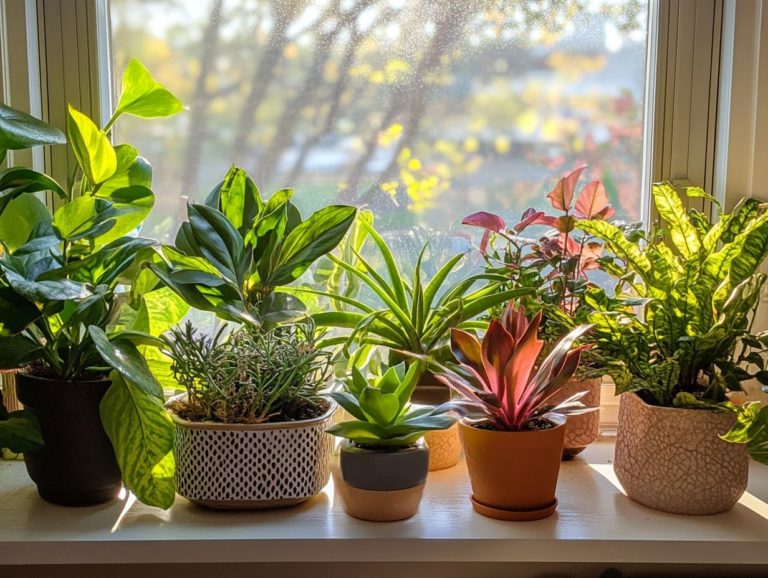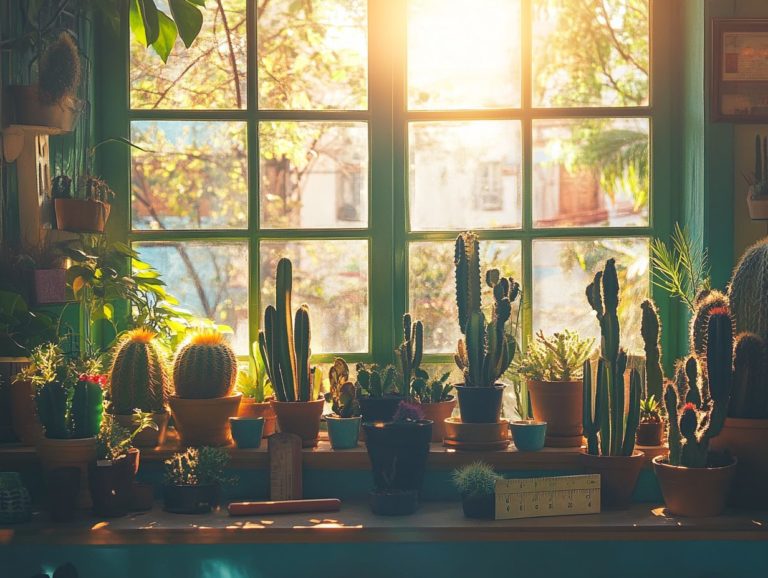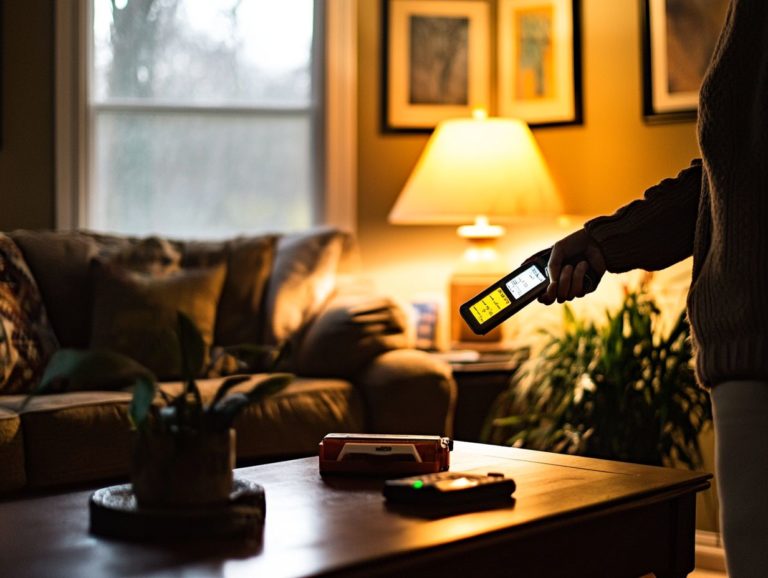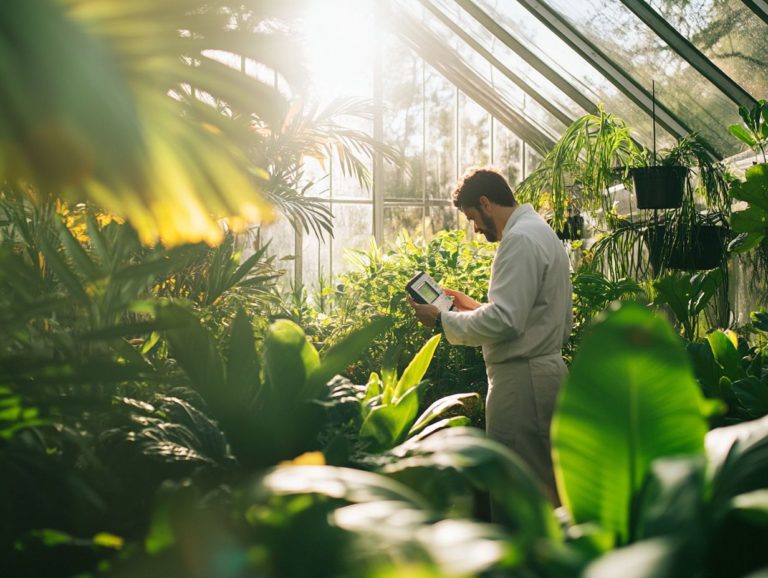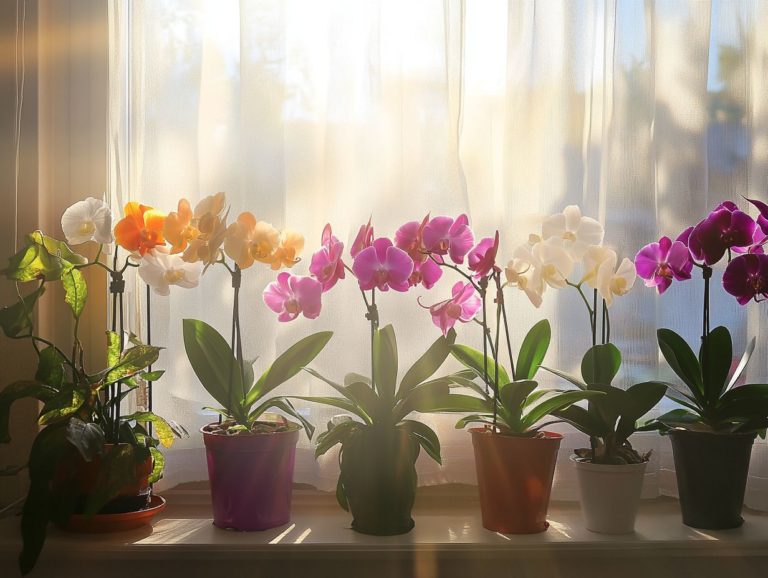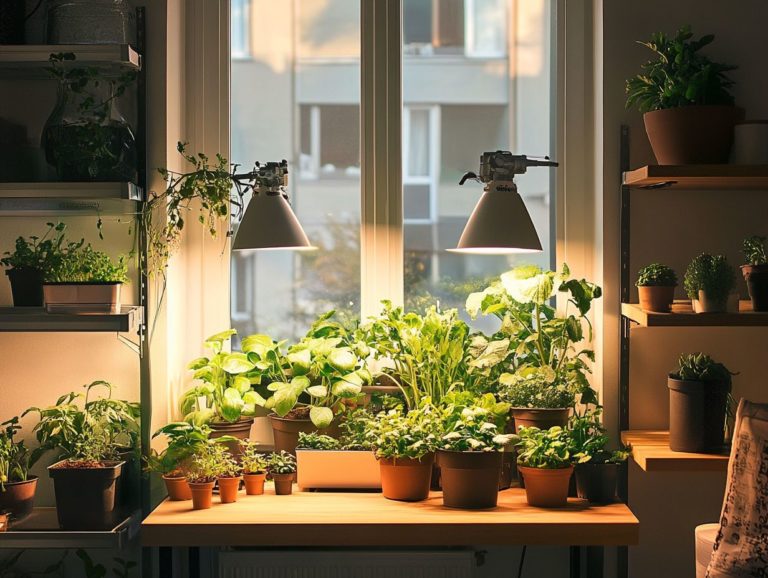How to Use Light for Indoor Vegetable Gardens
Indoor vegetable gardening offers a fulfilling opportunity to grow fresh produce right at home, no matter the outdoor space or climate you re dealing with.
This guide delves into the many benefits of cultivating vegetables indoors, highlighting the perks of year-round gardening. You will also learn effective harvesting techniques that help you enjoy your produce. Get ready to turn your space into a lively and fruitful garden!
You’ll uncover essential lighting options that guarantee your plants flourish, along with tips for setting up your indoor garden and best practices for maintenance.
Contents
- Key Takeaways:
- Benefits of Indoor Vegetable Gardens
- Choosing the Right Lighting
- Setting Up Your Indoor Garden
- Maintaining Your Indoor Garden
- Harvesting and Using Your Indoor Vegetables
- Frequently Asked Questions
- 1. What type of light is best for indoor vegetable gardens?
- 2. How far should grow lights be from my indoor vegetable garden?
- 3. Can I use regular household lights for my indoor vegetable garden?
- 4. How many hours of light do my indoor vegetables need?
- 5. Do I need to adjust the light cycle for different stages of plant growth?
- 6. Can I leave my grow lights on 24/7 for my indoor vegetable garden?
Key Takeaways:
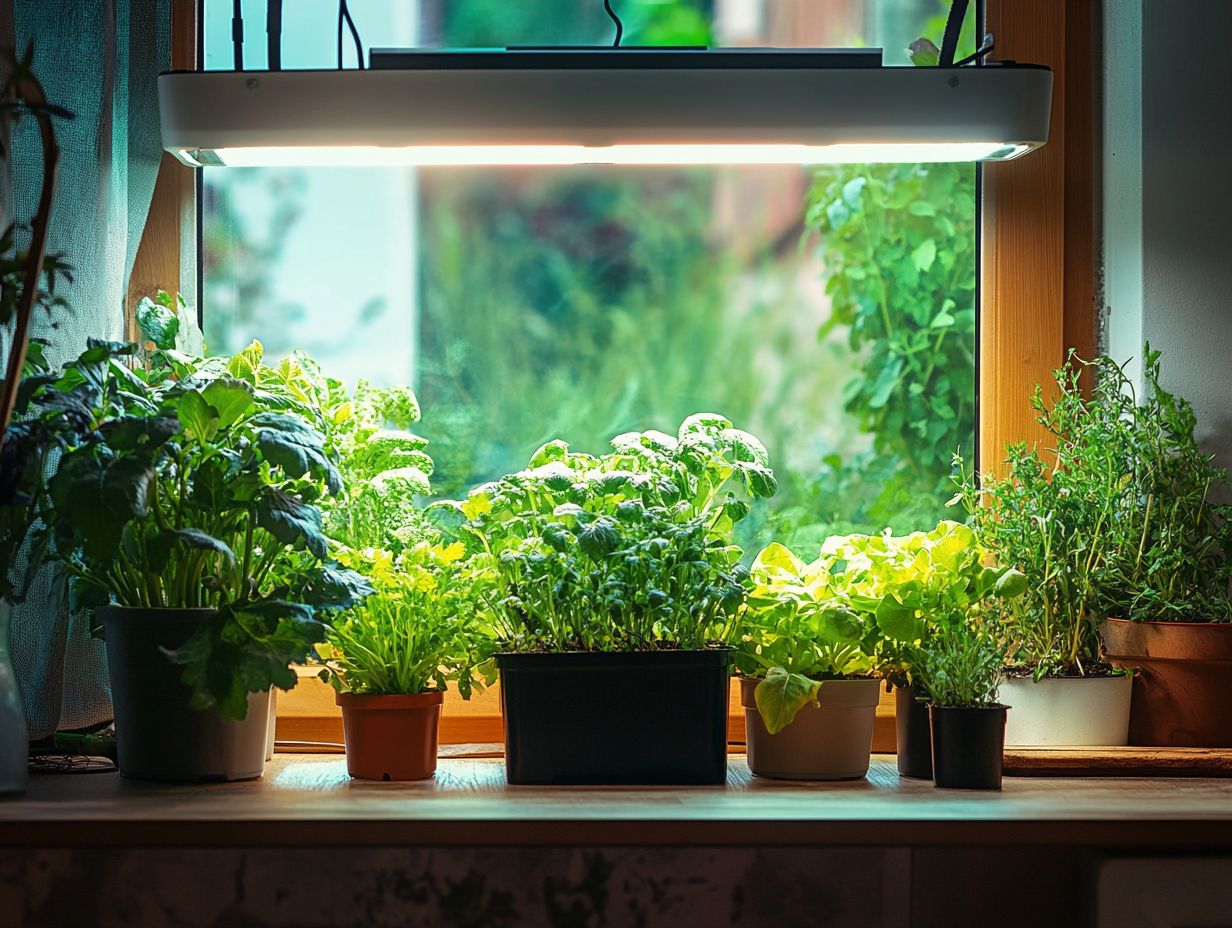
- Indoor vegetable gardens offer numerous benefits, such as year-round access to fresh produce and the ability to control growing conditions.
- When choosing lighting for your indoor garden, consider factors such as plants’ light requirements, intensity and duration of light, and energy efficiency.
- Proper maintenance, including watering and controlling pests, is crucial for the success of your indoor vegetable garden. Be sure to also properly harvest and store your produce for optimal freshness and flavor.
Benefits of Indoor Vegetable Gardens
Indoor vegetable gardens present a wealth of advantages tailored to urban dwellers and gardening aficionados alike, making them an appealing choice for anyone constrained by space or climate.
Imagine cultivating a diverse range of vegetables tomatoes, lettuce, and fragrant herbs right in your home. These gardens provide fresh produce year-round, meeting your nutritional needs while caring for your plants well.
You gain the ability to meticulously control every aspect of the growing conditions, from soil quality to light exposure, which significantly enhances both the health of your plants and the overall yield.
Why Grow Vegetables Indoors?
Growing vegetables indoors enables you to create the perfect light and growing conditions, leading to robust plant growth and an impressive harvest, even amidst the hustle and bustle of urban life.
This innovative approach not only alleviates the challenges posed by seasonal fluctuations but also allows you to indulge your passion for gardening throughout the year. Indoor gardening offers a remarkable opportunity to cultivate a diverse array of vegetables, regardless of the climate outside.
By utilizing various grow lights that mimic sunlight, you can customize the spectrum and intensity to suit different plant types, ensuring they receive the essential energy for photosynthesis, the process plants use to convert light into energy.
Establishing a controlled environment with the right temperature and humidity takes your indoor garden to the next level, making it easier than ever to achieve a thriving oasis of greenery.
Choosing the Right Lighting
Selecting the appropriate lighting for your indoor gardening endeavor is essential for fostering robust vegetable growth, especially when natural light falls short or fluctuates. In such cases, the use of grow lights becomes imperative, with LED grow lights standing out as a top choice.
These lights effectively replicate the full spectrum of sunlight, providing the necessary intensity and spectrum to cater to the specific requirements of a diverse array of plants, from crisp leafy greens like lettuce to vibrant flowering varieties.
Types of Lights for Indoor Gardens
You have a range of lighting options at your disposal for indoor gardens, each tailored to meet specific needs and conditions. Among these, LED lights stand out as the top choice, thanks to their remarkable energy efficiency and impressive lifespan.
Fluorescent lights, for example, are a budget-friendly option, perfect for seedlings and low-light plants, though they may struggle to reach the deeper foliage. If you’re working with larger spaces, high-output LEDs can be particularly advantageous, offering customizable spectrums that can be fine-tuned to match your plants’ growth stages. For more insights, check out these lighting tips for indoor herb gardens.
Incandescent bulbs are readily available, but they fall short in efficiency and tend to produce more heat, making them less suitable for dedicated gardeners. By understanding these nuances, you can make informed lighting choices that will greatly enhance your plants’ health and overall growth quality.
Factors to Consider When Selecting Lights
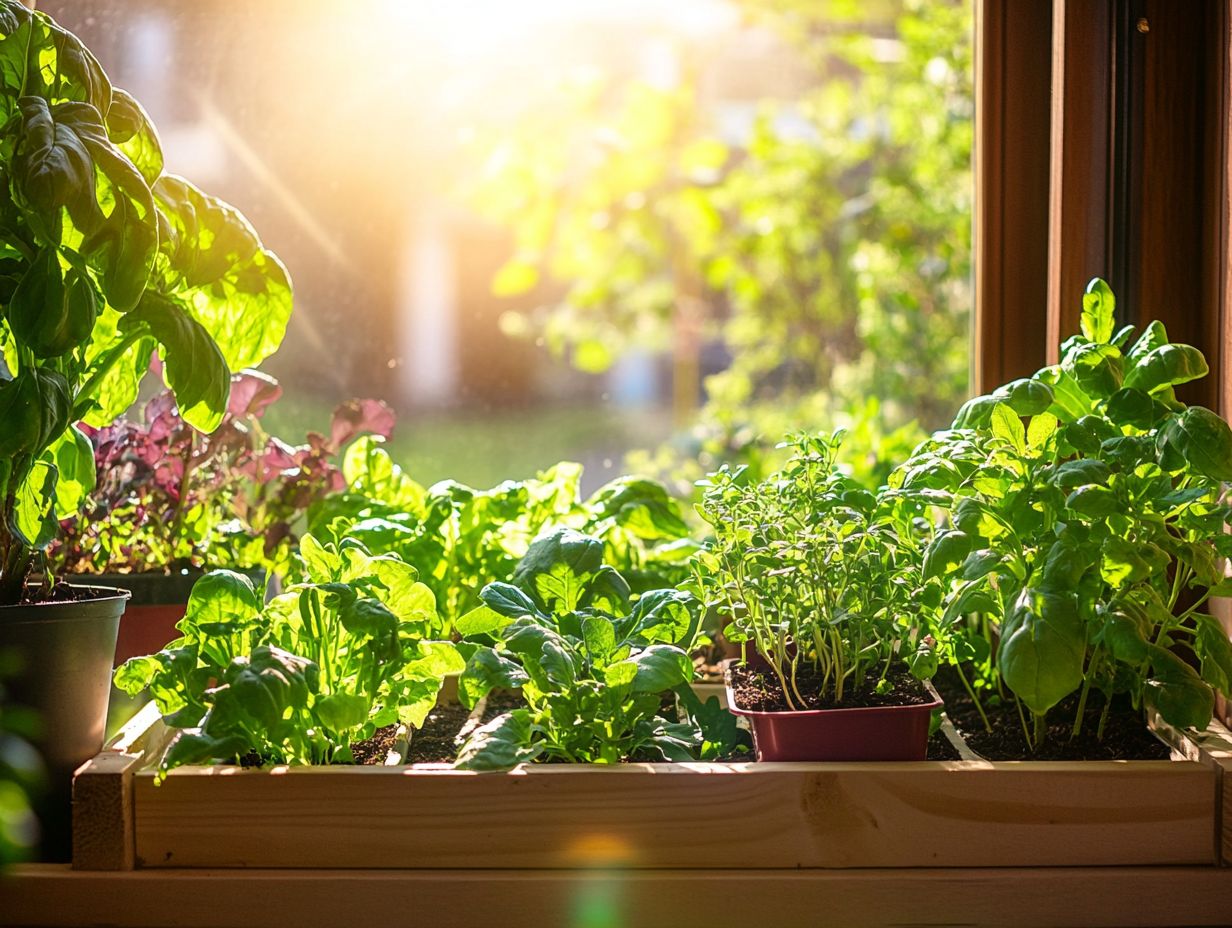
Selecting lights for your indoor garden is essential. Consider your plants’ specific light needs, the quality of light, and the color temperature that promotes growth.
Understanding the nuances of light spectrum, intensity, and duration allows you to customize your lighting setup. For example, tropical plants thrive under bright, direct lighting, while shade-tolerant varieties prefer softer, indirect illumination.
Adjusting light intensity can significantly impact growth. Too little light might stunt it, while excessive light can lead to stress.
The duration of light exposure is essential. Most plants flourish with a consistent amount of light each day. By considering these elements, you can create a balanced environment that nurtures healthy plants and vibrant life in your indoor garden.
Setting Up Your Indoor Garden
Establishing your indoor garden requires careful attention to key factors such as your available space, the choice of location, and the optimal lighting setup for healthy growth.
The arrangement of plants and lighting profoundly influences your indoor gardening success, fostering a thriving ecosystem where every type of plant can flourish.
Location and Space Requirements
Choosing the right location and understanding your space requirements are critical steps in creating a flourishing indoor garden, especially in limited areas.
Evaluate your available garden space by assessing the room s dimensions, furniture layout, and most importantly natural light. Observe how sunlight streams through your windows at different times of the day; this will guide you in placing your plants.
For example, south-facing windows typically provide the most light, while north-facing windows are ideal for shade-loving varieties.
To maximize your space, consider employing vertical gardening techniques like wall-mounted planters or trellises. This allows plants to grow upwards and use every inch of your area. Additionally, selecting compact or dwarf plant varieties can further enhance your garden while simplifying maintenance.
Arranging Lighting and Plants
Properly arranging the lighting and plants in your indoor garden ensures each plant receives the right amount of light while optimizing space and aesthetics.
Observe the natural light patterns in your area and consider how many hours of direct light each plant needs daily. Positioning your grow light bars correctly can significantly boost growth, especially for light-hungry varieties.
By placing these bars at different heights, you can achieve better coverage and reduce shadows, crucial for providing even illumination to all your plants. Monitor light intensity, as different plants have unique light needs. For more information on understanding indoor plant light needs, adjusting the distance of your grow lights helps create the perfect conditions for each plant, fostering vibrant growth.
Maintaining Your Indoor Garden
Maintaining your indoor garden requires a dedicated approach to watering, a keen eye for nutrient needs, and effective pest control strategies.
By consistently attending to these aspects, you can ensure your indoor crops flourish and thrive in their environment.
Start implementing these tips today for a flourishing indoor garden!
Watering and Nutrient Needs
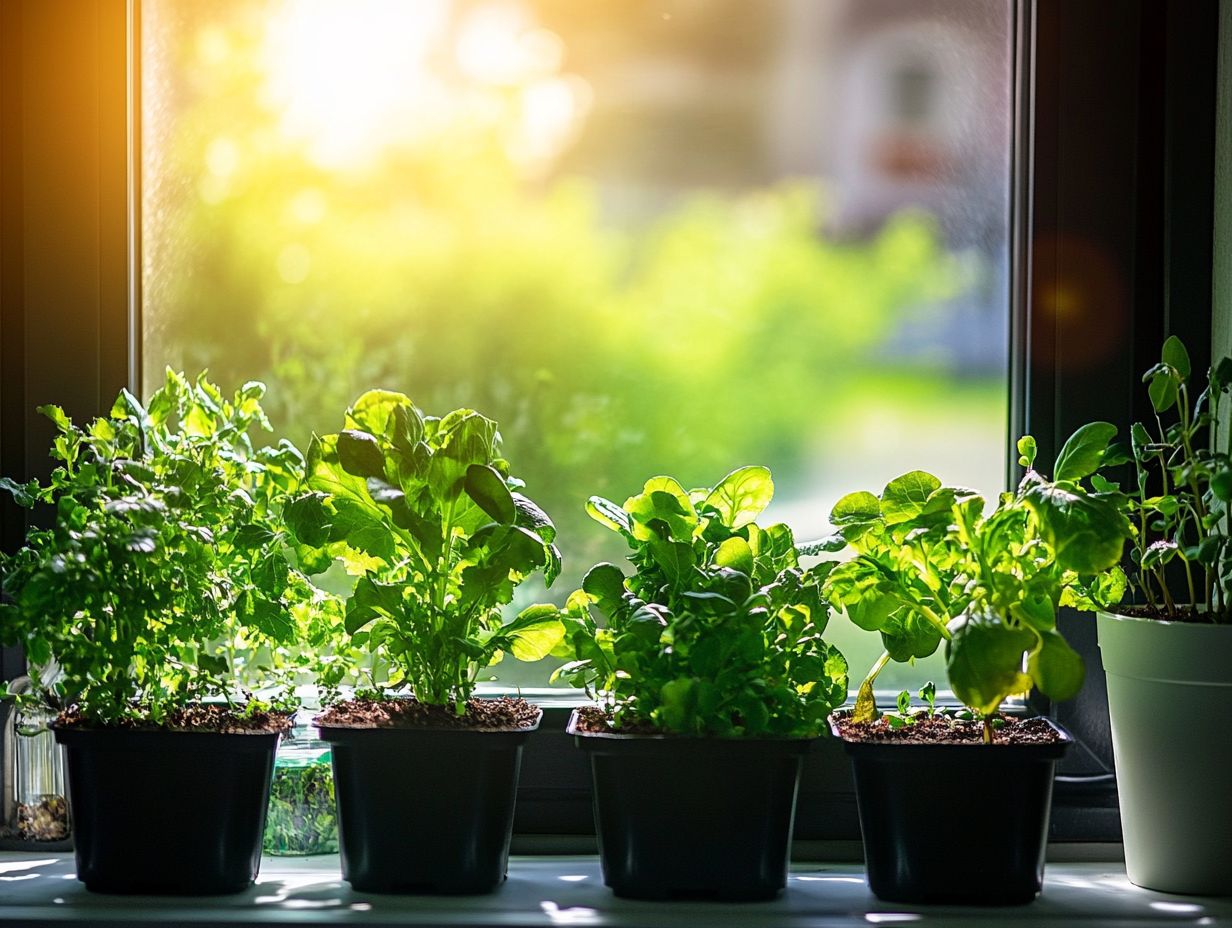
Watering your indoor plants and knowing their nutrient needs are vital for strong growth and preventing root rot.
Water when the top inch of soil feels dry. This may vary depending on your plant’s specific needs, environmental conditions, and pot size.
Using room-temperature water and ensuring good drainage can greatly improve your plants’ health.
Tailor nutrient delivery to each plant type; tropical plants and succulents have different requirements.
Adjust your fertilization schedule with slow-release or liquid fertilizers. This helps provide essential nutrients and promotes strong growth and disease resistance.
Pest Control and Other Considerations
Effective pest control is crucial for indoor gardeners. Protect your plants from common pests that can reduce growth and yield.
Without proper measures, issues can escalate and lead to stunted plants or crop loss. Explore organic solutions like neem oil and insecticidal soaps, alongside sanitation and regular inspections.
Monitor humidity and light to deter pests before they become a bigger problem.
By keeping a close eye on your plants, you can create a thriving environment free from pests.
Harvesting and Using Your Indoor Vegetables
Harvest your indoor vegetables at the perfect moment. This not only allows you to enjoy fresh produce but also prepares for the next growth cycle.
Tips for Harvesting and Storing Fresh Produce
To keep your fresh produce flavorful and nutritious, use proper harvesting techniques and effective storage methods designed for indoor vegetables.
Different vegetables need unique approaches. For instance, pick leafy greens like lettuce in the morning to retain crispness, while gently twist root vegetables to avoid breakage.
Immediately handle the vegetables after harvesting. Rinse them gently to remove soil, and pat them dry with a soft cloth.
For storage, use breathable bags for leafy greens to prevent moisture buildup. Store root vegetables in cool, dark spaces to maintain freshness and nutrients.
Frequently Asked Questions
1. What type of light is best for indoor vegetable gardens?
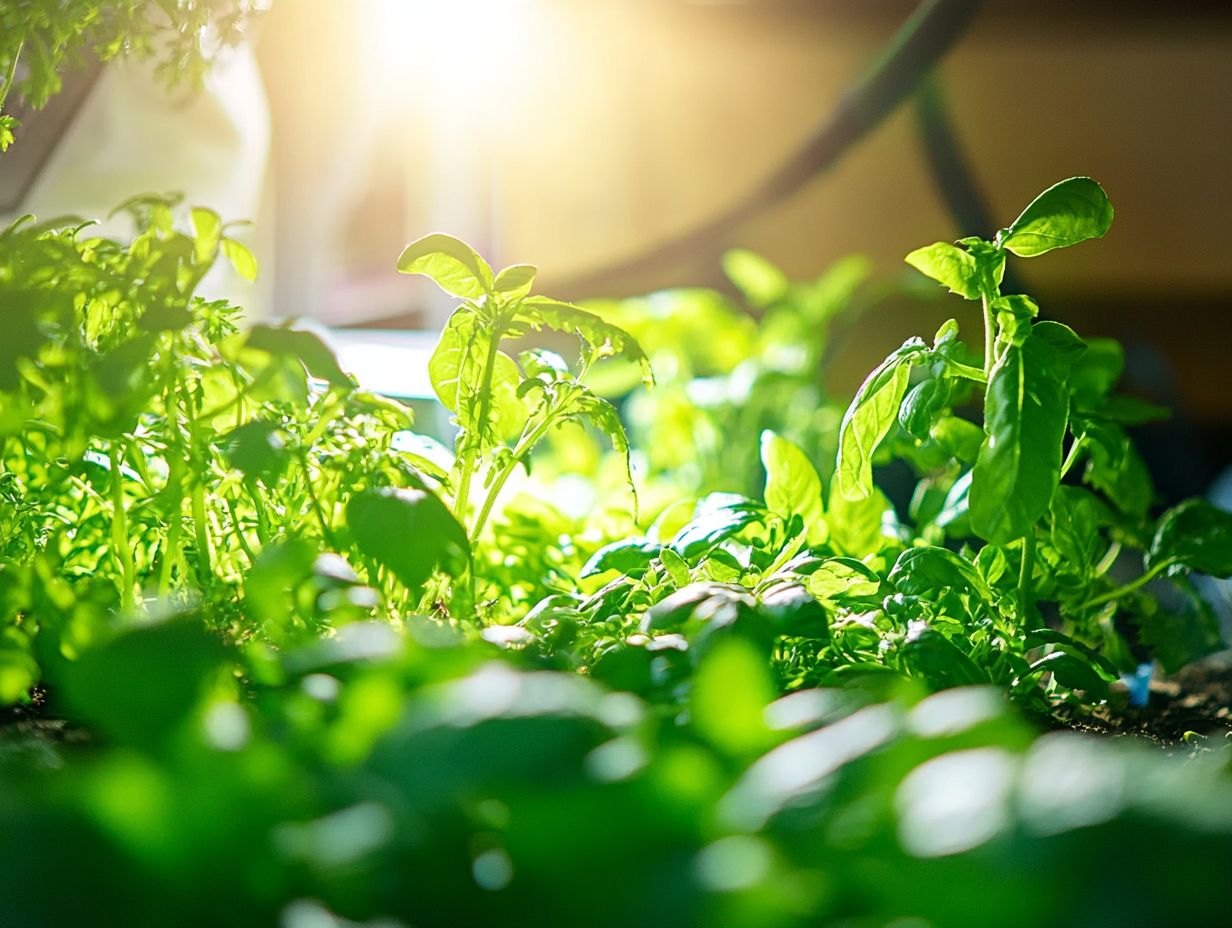
Full-spectrum LED grow lights are the best and most energy-efficient for indoor vegetable gardens. They mimic natural sunlight to promote optimal plant growth.
2. How far should grow lights be from my indoor vegetable garden?
The distance between grow lights and plants depends on the type of light and garden size. Generally, place LED lights 12-24 inches above plants and fluorescent lights 6-12 inches away.
3. Can I use regular household lights for my indoor vegetable garden?
No, regular household lights don’t provide the light spectrum needed for plant growth. Invest in full-spectrum grow lights designed for plants instead.
4. How many hours of light do my indoor vegetables need?
Most vegetables thrive on 12 to 16 hours of light each day. Always check the specific needs of each type of vegetable.
5. Do I need to adjust the light cycle for different stages of plant growth?
Plants require different types of light at various stages. In the growing stage, they benefit from more blue light, while they need more red light when blooming.
6. Can I leave my grow lights on 24/7 for my indoor vegetable garden?
Plants need darkness to rest and recharge. Keeping grow lights on all the time can stress them out and stunt their growth. Use a timer to provide the right balance of light and darkness.

